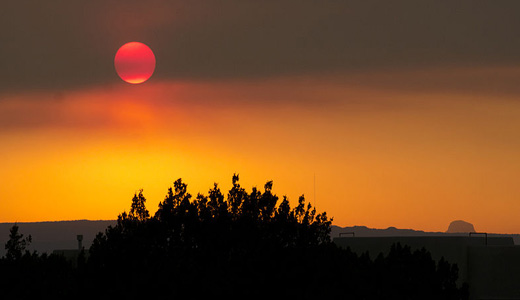
On the week of June 12, around 7,000 residents from two Arizona towns evacuated when the Wallow Fire got out of control. Firefighters struggled to keep the blaze from spreading, but could only do their best as the flames burned through the Apache-Sitgreaves National Forest, believed to be the result of an abandoned campfire, VOA News reported.
The Wallow Fire, named after the Bear Wallow Wilderness where it originated, has already destroyed around 30 homes and blackened 733 square miles of land. At this time, only 33 percent of the inferno has been contained. This fire has already surpassed the 2002 Rodeo-Chediski Fire in magnitude, making it the largest wildfire in Arizona’s history.
As a result, noted the Arizona AFL-CIO, thousands of families, including IBEW Local 1116 union members, have been displaced. Those who were lucky enough to return to their homes now face dangerous levels of air pollution caused by the fire.
Rebekah Friend, executive director, secretary, and treasurer of the Arizona AFL-CIO, asked for people to make contributions to the American Red Cross, in order to help provide food and shelter for the wildfire evacuees.
Despite combative efforts, fires also grew in New Mexico and at the state’s border with Colorado, said the Times Union.
In Luna, N.M., evacuation plans are in place for the 200 residents. Officials in Catron County told them to be prepared to leave if winds push the blaze into western New Mexico.
On June 15, USA Today said that investigators were questioning two “persons of interest” in regard to the origin of the blaze.
However, campfire mishaps are not the only cause of these destructive fires.
In the case of this fire, extremely windy and arid conditions helped the blaze spread and consume plant life, said fire task force spokesman Terry Stemmler, in a report by the Huffington Post.
According to PBS, Peter Frumhoff, director of science and policy for the Union of Concerned Scientists, said, “Basically what we know is that across the western United States, both frequency and length of fire season has been increasing in recent decades, since the 1990s.”
In a piece for Common Dreams, Carl Pope, chairman of the Sierra Club, said of recent disastrous events like wildfires, “The states facing this fury are, for the most part, represented in Congress by die-hards who advocate continuing climate disruption by choking the atmosphere with greenhouse pollution. While some of these folks claim that the whole idea of global warming is a hoax, what they really believe is that while the climate is warming, we should let the future worry about it, because adjusting to new weather patterns is cheaper than giving up our addiction to coal, oil and carbon waste.”
In a report by Climate Progress, writer Joe Romm linked the overall increase in western wildfires to global warming. He referenced Arizona’s Rodeo-Chediski Fire, which consumed 468,000 acres, and noted that unrestricted greenhouse gases will result in these types of disasters becoming commonplace.
In a 2009 study, Romm reported, “We show that increases in temperature cause annual mean area burned in the western United States to increase by 54 percent by the 2050s relative to the present-day. Increased area burned results in near doubling of wildfire carbonaceous aerosol emissions by mid-century.”
Photo: Smoke from the 2011 Arizona wildfire, as seen during a sunset in Albuquerque, N.M. John Fowler // Wikipedia










